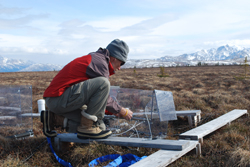Update
PolarTREC Teacher expedition to Mt Kilimanjaro!
John Wood participated in a GLOBE Seasons and Biomes expedition to Mt. Kilimanjaro. The team was in Africa from 18 September - 3 October, 2012. The team also posted journals through the Globe Xpedition Page.
Webinars from Mt. Kilimanjaro
John Wood's Kilimanjaro expedition hosted two webinars - 26 September 2012 and 1 October 2012. All webinar archives are available on the PolarConnect Archives Page
What Are They Doing?

The research team studied changes to the carbon cycle in northern forests by setting up experiments that simulate a warmer and dryer tundra. When they arrived at the field site they first removed snow from the research sites and then set up an automated carbon dioxide measurement system and warming chambers. After the set-up, the team took field measurements of carbon dioxide exchange between the soil and atmosphere, permafrost thaw depth, and water table depth. In addition, they took plant and soil samples and studied the timing of plant life events, also known as phenology. In 2012, the team also took methane and radiocarbon measurements.
The experiment was part of the Carbon in Permafrost Experimental Heating Research (CiPEHR) project. The results of their research will help in predicting how the warming and drying tundra will affect the carbon balance, and how the release of additional carbon dioxide will affect global climate change.
Where Are They?

Latest Journals
Sue Natali is an assistant scientist at Wood Hole Research Center (WHRC). Her research focuses on the interactions and feedbacks between plant and soil communities and their environment and seeks to better understand the impacts of environmental change on ecological processes and biogeochemical cycles. Dr. Natali conducts her research in boreal and tundra ecosystems in Alaska and Siberia. Learn more about Dr. Natali and her work at the WHRC webpage.


